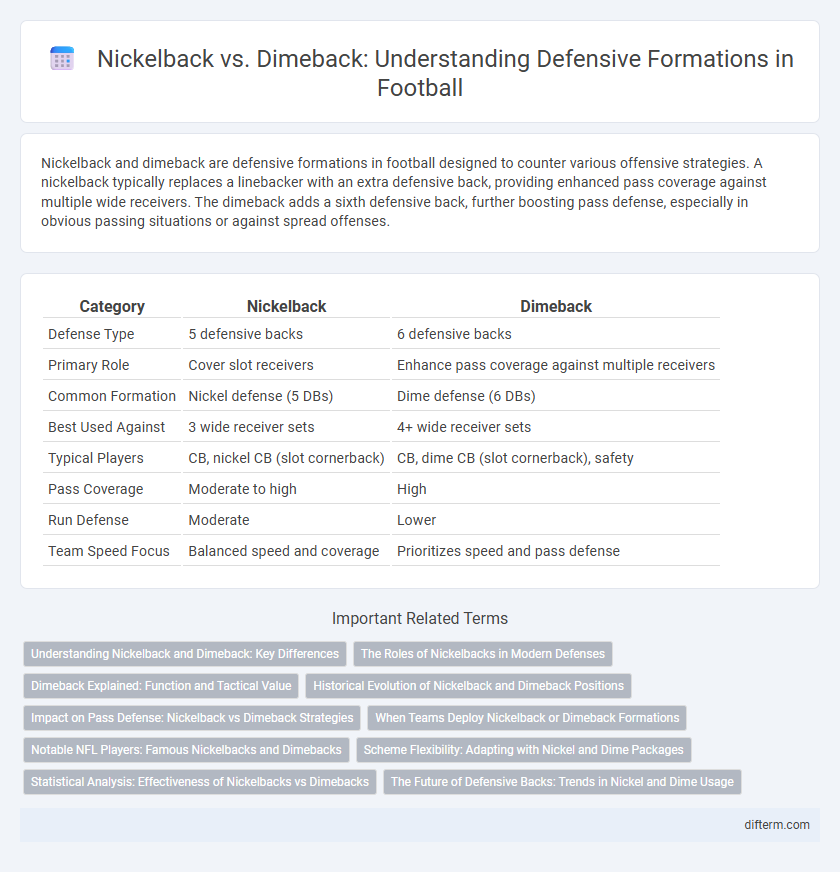Nickelback and dimeback are defensive formations in football designed to counter various offensive strategies. A nickelback typically replaces a linebacker with an extra defensive back, providing enhanced pass coverage against multiple wide receivers. The dimeback adds a sixth defensive back, further boosting pass defense, especially in obvious passing situations or against spread offenses.
Table of Comparison
| Category | Nickelback | Dimeback |
|---|---|---|
| Defense Type | 5 defensive backs | 6 defensive backs |
| Primary Role | Cover slot receivers | Enhance pass coverage against multiple receivers |
| Common Formation | Nickel defense (5 DBs) | Dime defense (6 DBs) |
| Best Used Against | 3 wide receiver sets | 4+ wide receiver sets |
| Typical Players | CB, nickel CB (slot cornerback) | CB, dime CB (slot cornerback), safety |
| Pass Coverage | Moderate to high | High |
| Run Defense | Moderate | Lower |
| Team Speed Focus | Balanced speed and coverage | Prioritizes speed and pass defense |
Understanding Nickelback and Dimeback: Key Differences
Nickelback and dimeback are defensive formations in American football that involve extra defensive backs to counter passing offenses. A nickelback is the fifth defensive back added to the base defense, typically replacing a linebacker, enhancing pass coverage against three-wide receiver sets. The dimeback, on the other hand, is the sixth defensive back, often used in obvious passing situations to provide even greater coverage against multiple wide receivers, emphasizing speed and agility over run defense.
The Roles of Nickelbacks in Modern Defenses
Nickelbacks play a critical role in modern NFL defenses by providing additional pass coverage against increasingly prevalent three-receiver sets. Unlike dimebacks who are primarily used in obvious passing situations, nickelbacks are versatile hybrid defenders capable of covering slot receivers, supporting run defense, and blitzing the quarterback. Their ability to quickly adapt to both man and zone coverage schemes makes nickelbacks essential for countering fast-paced, pass-heavy offenses.
Dimeback Explained: Function and Tactical Value
A dimeback, a defensive back in American football, is primarily deployed in passing situations to cover slot receivers, providing extra pass defense beyond the nickelback's coverage scope. Typically the fifth or sixth defensive back, the dimeback enhances a defense's ability to counter multiple receiver formations, improving containment and interception rates. This specialized role allows defensive coordinators to adapt quickly to spread offenses, emphasizing speed and coverage versatility over traditional run support.
Historical Evolution of Nickelback and Dimeback Positions
The nickelback and dimeback positions evolved as defensive responses to the increasing use of pass-heavy offenses in football during the late 20th century. The nickelback, typically the fifth defensive back, emerged in the 1960s to cover slot receivers, while the dimeback, the sixth defensive back, gained prominence in the 1980s as offenses incorporated more complex passing schemes. These roles have continually adapted through tactical innovations, emphasizing speed and coverage skills to counter evolving aerial attacks.
Impact on Pass Defense: Nickelback vs Dimeback Strategies
Nickelback formations, featuring five defensive backs, prioritize pass defense by enhancing coverage against slot receivers and tight ends, effectively disrupting short to intermediate passing routes. Dimeback sets add a sixth defensive back, intensifying pass coverage and boosting flexibility to counter multiple wide receiver sets, thereby reducing passing lanes and increasing quarterback pressure. Both strategies adjust defensive alignments to optimize coverage efficiency and limit opponent passing effectiveness in high-stakes game scenarios.
When Teams Deploy Nickelback or Dimeback Formations
Teams deploy nickelback formations primarily against offenses that emphasize passing with multiple wide receivers, as the extra defensive back improves coverage on third-down and long-yardage situations. Dimeback formations, featuring six defensive backs, are reserved for obvious passing downs or prevent defenses to counteract four or more receiver sets, enhancing pass defense at the expense of run stopping. Coaches analyze offensive tendencies, down and distance, and field position to decide the optimal defensive backfield alignment for each play.
Notable NFL Players: Famous Nickelbacks and Dimebacks
Notable NFL players like Richard Sherman and Aqib Talib have excelled as nickelbacks, showcasing agility and coverage skills required to defend slot receivers. Dimebacks like Ronde Barber and Darrelle Revis have gained recognition for their ability to shut down multiple receiver sets and support nickel packages. These specialists are vital for teams deploying complex defensive schemes against modern passing offenses.
Scheme Flexibility: Adapting with Nickel and Dime Packages
Nickelback and dimeback packages enhance defensive scheme flexibility by allowing defensive coordinators to adjust coverage based on offensive formations. The nickel package, featuring five defensive backs, provides a balanced approach against both run and pass plays, while the dime package, with six defensive backs, specializes in countering spread offenses and deep passing attacks. Implementing these packages facilitates dynamic defensive alignment, improving adaptability to diverse offensive strategies and optimizing pass coverage without sacrificing run defense.
Statistical Analysis: Effectiveness of Nickelbacks vs Dimebacks
Nickelbacks demonstrate versatility by effectively covering slot receivers and supporting run defense, boasting an average of 3.2 tackles and 1.1 pass deflections per game compared to dimebacks' 2.8 tackles and 0.9 pass deflections. Dimebacks, specializing in pass coverage with an emphasis on slot receiver assignments, record higher interception rates, averaging 0.4 per game versus nickelbacks' 0.3. Statistical analysis reveals nickelbacks contribute more in tackling situations while dimebacks excel in pass defense efficiency, highlighting situational advantages for each defensive back type.
The Future of Defensive Backs: Trends in Nickel and Dime Usage
Nickel and dime defensive packages are evolving as the NFL shifts toward pass-heavy offenses, increasing the demand for versatile defensive backs skilled in coverage and run support. Teams are integrating hybrid players capable of adapting between nickel cornerback and dime safety roles, emphasizing speed, agility, and football IQ to counter dynamic wide receiver sets. Data from recent seasons show a rising trend in dime package usage, reflecting defenses' strategic pivot to deploying five or six defensive backs to optimize pass defense efficiency.
nickelback vs dimeback Infographic

 difterm.com
difterm.com